

Kinder (goat) The Kinder is a breed of goat, originating from a cross between a pygmy goat and a Nubian goat in 1985 at Zederkamm Farm.
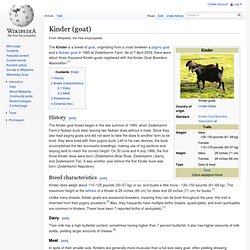
As of 7 April 2009, there were about three thousand Kinder goats registered with the Kinder Goat Breeders Association.[1] The Kinder goat breed began in the late summer of 1985, when Zederkamm Farm's Nubian buck died, leaving two Nubian does without a mate. Since they also kept pygmy goats and did not want to take the does to another farm to be bred, they were bred with their pygmy buck. Left to his own devices, the buck accomplished the two successful breedings, making use of log sections and sloping land to reach the correct height. On 30 June and 4 July 1986, the first three Kinder does were born (Zederkamm Briar Rose, Zederkamm Liberty, and Zederkamm Tia).
Kinder does weigh about 110–125 pounds (50–57 kg) or so, and bucks a little more - 135–150 pounds (61–68 kg). Bukharan Markhor. The Bukharan Markhor, also known as Turkomen Markhor or Tadjik Markhor (Capra falconeri heptneri) is an endangered goat-antelope, native to Tajikistan, Pakistan, Turkmenistan and Uzbekistan, possibly also Afghanistan.

Today it is found in few scattered populations, for example in Kugitang Nature Reserve in easternmost Turkmenistan.[2] References[edit] Jump up ^ Valdez, R. (2008). Capra falconeri. In: IUCN 2008. See also[edit] Markhor. Garganica. The Garganica is a breed of goat which originated on the Gargano promentary in the Italian region of Puglia.
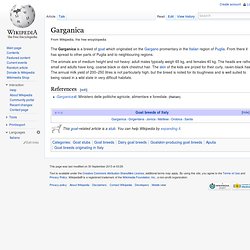
From there it has spread to other parts of Puglia and to neighbouring regions. Garganica, Ministero delle politiche agricole, alimentare e forestale. (Italian) Girgentana (goat) Girgentana goats The Girgentana goat breed takes its name from the city of Agrigento, Sicily (in Sicilian Girgenti) where in the past there were present more than 30,000.

Today, however, this breed is in danger of disappearance. Golden Guernsey. Golden Guernseys eat pumpkin.

Anglo-Nubian. The Anglo-Nubian, or simply Nubian in the United States, is a breed of domestic goat.
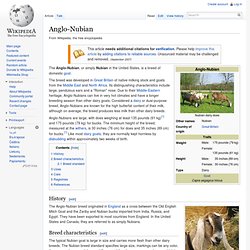
The breed was developed in Great Britain of native milking stock and goats from the Middle East and North Africa. Its distinguishing characteristics include large, pendulous ears and a "Roman" nose. Due to their Middle-Eastern heritage, Anglo-Nubians can live in very hot climates and have a longer breeding season than other dairy goats. Considered a dairy or dual-purpose breed, Anglo-Nubians are known for the high butterfat content of their milk, although on average, the breed produces less milk than other dairy breeds.
Anglo-Nubians are large, with does weighing at least 135 pounds (61 kg)[1] and 175 pounds (79 kg) for bucks. Murciana goat. American Lamancha goat. {{about||the plateau in Spain|La Mancha|the La Mancha wine region|La Mancha (DO)|the Spanish goat|Murciana LaMancha doe in the show ring Lamancha goats are perhaps the most distinctive goat breed;[3] easily recognizable by their very short ear pinnae.[1] They are also known for their high milk production, and the comparatively high butterfat content in their milk.[2] The short-eared American Lamanchas first gained recognition as a distinct breed in the early 1950s,[4] and the breed was registered formally on January 27, 1958[5] as "Lamancha or American Lamancha" goats.[6] Approximately 200 animals were accepted at registration as its original stock.[5] The first true American Lamancha goat registered was named Fay's Ernie, L-1.[5]
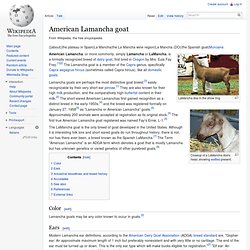
Nigerian Dwarf (goat) The Nigerian Dwarf goat is a miniature dairy goat breed of West African ancestry.
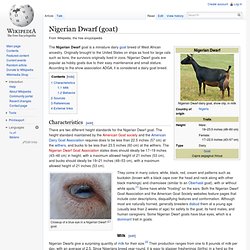
Originally brought to the United States on ships as food for large cats such as lions, the survivors originally lived in zoos. Nigerian Dwarf goats are popular as hobby goats due to their easy maintenance and small stature. Boer goat. A Boer goat buck The Boer goat is a breed of goat that was developed in South Africa in the early 1900s for meat production.

Their name is derived from the Afrikaans word "boer", meaning farmer. Origins and characteristics[edit] The Boer goat was probably bred from the indigenous goats (they originated from South Africa) of the Namaqua Bushmen and the Fooku tribes, with some crossing of Indian and European bloodlines being possible. They were selected for meat rather than milk production; due to selective breeding and improvement, the Boer goat has a fast growth rate and excellent carcass qualities, making it one of the most popular breeds of meat goat in the world. Boer goats commonly have white bodies and distinctive brown heads. Dutch Landrace. Dutch Landrace Buck.
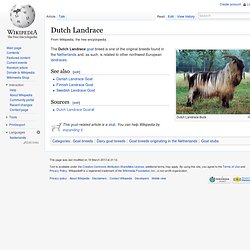
Booted Goat. A Stiefelgeiss. Stiefelgeiss is a breed of domestic mountain goats originating in the highlands of St. Gallen, Switzerland. Their population is currently less than one thousand. Both male and female Stiefelgeiss goats have horns. Their coats range from a light greyish brown to a dark reddish color. Markhor. Names[edit] Etymology[edit] The colloquial name is thought by some to be derived from the Persian word mar, meaning snake, and khor, meaning "eater", which is sometimes interpreted to either represent the species' ability to kill snakes, or as a reference to its corkscrewing horns, which are somewhat reminiscent of coiling snakes.[2] According to folklore (Explanation by Shah Zaman Gorgani), the markhor has the ability to kill a snake and eat it.
Thereafter, while chewing the cud, a foam-like substance comes out of its mouth which drops on the ground and dries. This foam-like substance is sought after by the local people, who believe it is useful in extracting snake poison from snake bitten wounds. Local names[edit] Physical description[edit] Majorera. The cabra majorera or Fuerteventura goat is a breed of dairy goat native to the Canary Islands. Majorero cheese is made from its milk. It is a particularly strong breed, and has been exported to Africa and Latin America. Don Goat.